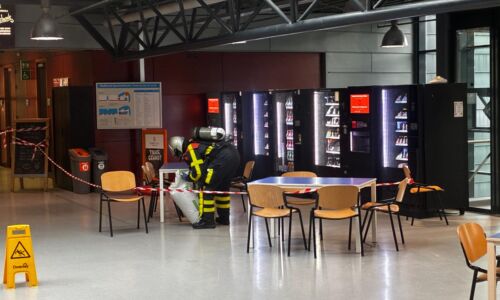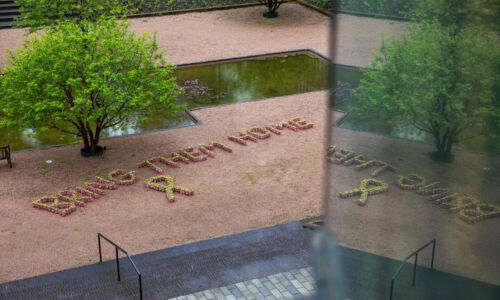University dials back on gas consumption with system of pipes and heat pumps
A gaping hole in the ground is what visitors saw the past year when entering the Huygens building. ‘What you saw there was the new technology basement in the works,’ says Geert Jansen, project manager at Campus & Facilities. ‘It was necessary in order to place two new big heat pumps. The old technology space didn’t have enough room for them.’
Those heat pumps play an important role in the sustainable heating of multiple buildings on the east side of the campus. After all, the pumps function on electricity, not on natural gas. On August 3, a big crane placed them in the new technology space. The construction site was closed again afterwards.
Pipes
The Huygens building was not the only place of visible construction. The ground was also opened behind the Refter and on the west side of the Berchmanianum. These two sites were connected by pipes with a diameter of 25 centimeter (9.8 inch) that run from the Erasmus building to the Berchmanianum. This was placed by directional drilling so the start and end could be calculated accurately without digging through the whole area – part of the forest would have to be cleared for that.
All those new pipes and heat pumps contribute to the expansion of what the university calls the hybrid energy grid. ‘This system enables us to exchange warmth and coldness between buildings,’ says Tom van Onna, manager energy at Campus & Facilities. ‘This way, we’ll decrease gas consumption.’
‘We expect to reduce gas consumption by 400,000 cubic meter per year’
Older buildings (for example: Erasmus) often have to be heated while new buildings (Grotius, Montessori) have to be cooled because they are insulated properly. ‘For example, during a mild autumn day, if it’s around 15 degrees outside,’ says Van Onna. ‘The warmth from the new buildings will flow via the pipe system to the old buildings, so that the boiler barely has to be used.’
Because the new buildings don’t have their own gas boiler anymore, the warmth will travel the other way during the really cold days. This way, the heat pumps and the gas boiler in the Erasmus building will also heat the new buildings.
By connecting the Berchmanianum to the hybrid energy grid, a former bulk consumer of gas has been added to the system. Thus, the academics building, where a lot of supporting staff works, can be heated in a much more sustainable way.
Return of investments
The expansion of the energy grid does not only contain the Berchmanianum. The greenhouses behind the Huygens building, the Forum and Mercator I & II have also been added to the new system in the past academic year. The heating for childcare and office building the ‘Gele Vlieger’ comes from the greenhouses and is now automatically connected as well. ‘With all these interventions, we expect to reduce gas consumption by 400,000 cubic meters per year,’ says Van Onna. That’s a reduction of around 40%.
This obviously saves a large amount of money, especially with the current energy prices. Originally, the return of investments was thought to be 16 years but this payback period can be shortened to less than 10 years if the energy prices remain as high as they are now.
‘Warmth from the HFML still largely evaporates into the air’
Eventually, the plan is to reduce gas consumption to zero. Van Onna thinks this can be achieved by 2035. ‘But, for that to happen, a lot has yet to be done,’ he says. ‘The hybrid energy grid has to be expanded further and older buildings have to be renovated or torn down.’ Energy also has to be used in a smarter, more beneficial way. ‘The HFML (the magnet laboratory) is cooled but the warmth that is emitted in the process still largely evaporates into the air. Together with the HFML, we will find out how this warmth can be used for the hybrid energy grid.’
Storing warmth in the soil
Even during the harshest winter days, the university is not fully dependent on gas consumption. Then, the heat and cold storage (HCS) plays an important role. ‘That is a form of seasonal storage,’ says Tom van Onna. ‘In the summer, we put warmth into the soil which is held by the groundwater. Half a year later we can pump the warmth up again and use it for heating.’ The university uses five warm and five cold wells.
For now, Radboud University and the umc have their own separate HCS but the expectation is that these two will be connected in the future. ‘That would be beneficial,’ says Van Onna. ‘The hospital cools a lot of spaces which means they have a lot of leftover warmth. We could really use that warmth.’



